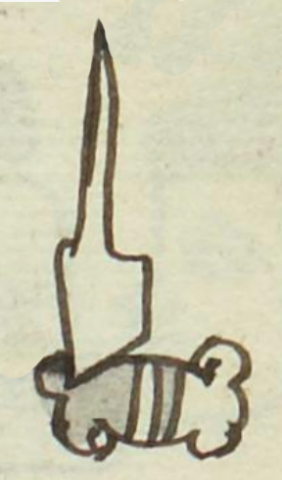Tetl Ihuic (MH552r)
This black-line drawing of the compound glyph for the personal name Tetl Ihuic (or perhaps Tetlihuic, "The Digging Stick for Rocks," attested here as a man’s name) shows a frontal view of a vertical digging stick that resembles a shovel (perhaps showing some European influence over the autonomous-era digging stick), as it seems to have a wider blade than usual. Below the agricultural tool is a horizontal stone with the typical curling ends and two-tone diagonal design across the middle.
Stephanie Wood
The gloss suggests a reading of the stone possessing the digging stick (with the word retaining its absolutive ending and the stick having a possessive pronoun attached to it). But the translation that makes the most sense is that this stick was used for especially rock soil, perhaps for digging rocks out of the soil. Of course, this is not to deny that stones could be considered animated and able to possess something.
Stephanie Wood
diegū tetliyhuic
Diego Tetl Ihuic (or Tetlihuic)
Stephanie Wood
1560
José Aguayo-Barragán and Stephanie Wood
tools, herramientas, piedras, stones, agricultura

te(tl), stone, https://nahuatl.wired-humanities.org/content/tetl-0
i-, his-her, https://nahuatl.wired-humanities.org/content/ipeuhcan
huic(tli), agriculture, https://nahuatl.wired-humanities.org/content/huictli
"El Palo para Excavar Piedras"
Stephanie Wood
Matrícula de Huexotzinco, folio 552r, World Digital Library. https://www.loc.gov/resource/gdcwdl.wdl_15282/?sp=183&st=image
This manuscript is hosted by the Library of Congress and the World Digital Library; used here with the Creative Commons, “Attribution-NonCommercial-ShareAlike 3.0 License” (CC-BY-NC-SAq 3.0).



